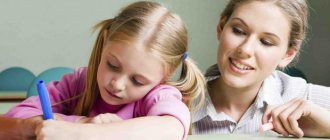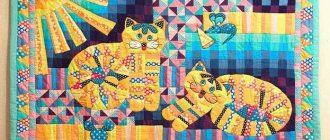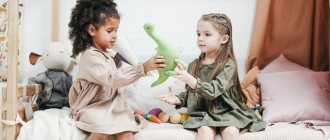MAGAZINE Preschooler.RF
PROGRAM for the artistic and aesthetic development of children through the means of fine arts in preschool educational institutions (in accordance with the Federal State Educational Standard)The program was compiled by: art teacher: Salimova V.A. methodologist: Lozko V.Yu. Khanty-Mansiysk
“In children’s creativity (with proper guidance) the child’s self-expression and self-affirmation occurs, his individuality is clearly revealed” (V. A. Sukhomlinsky)
I. EXPLANATORY NOTE
Relevance. Drawing is one of the most important means of understanding the world and developing knowledge of aesthetic education, since it is associated with the independent practical and creative activity of the child. In the process of drawing, a child’s observation and aesthetic perception, artistic taste and creative abilities are improved. By drawing, the child forms and develops certain abilities: visual assessment of shape, orientation in space, sense of color. Special skills and abilities are also developed: eye-hand coordination, hand control.
Systematic mastery of all necessary means and methods of activity provides children with the joy of creativity and their all-round development (aesthetic, intellectual, moral-labor, physical). And also, it allows you to fruitfully solve the problems of preparing children for school.
The works of domestic and foreign specialists indicate that artistic and creative activity performs a therapeutic function, distracting children from sad, distressing events, grievances, relieving nervous tension and fears. Causes a joyful, upbeat mood and ensures a positive emotional state for every child.
The content of the educational field “Artistic Creativity” is aimed at achieving the goals of developing interest in the aesthetic side of the surrounding reality, satisfying children’s need for self-expression through solving the following tasks:
- development of children's productive activities (drawing, modeling, appliqué, artistic work);
- development of children's creativity;
- introduction to the fine arts.
This program is based on an understanding of the priority of educational work aimed at developing perseverance, accuracy, patience, the ability to concentrate, fine motor skills and coordination of hand movements in children.
Novelty. For a long time, the main task of the circle was to teach children fine arts skills using traditional and non-traditional drawing techniques. But work practice shows that the full artistic and aesthetic development of a child is impossible without his moral education. Personality, like an artistic image, represents the unity of form and content in their interdependence.
The moral qualities of preschoolers are actively developing through exposure to art, music, literature, and folk culture. The integration of aesthetic feelings and moral experiences creates the basis for understanding the value of everything created by nature and man.
In each section of the program, the line of development of social and aesthetic feelings becomes an obligatory component of the education and development of preschool children.
Also, a distinctive feature of this program is the development of the communicative abilities of preschoolers based on their own creative activity.
The program was developed in accordance with the current Federal State Educational Standard and is an innovative educational program document.
This program develops in children the creative abilities they need for subsequent training in fine arts at school.
Type of program: compiled - compiled on the basis of various developments and collections:
- I.A. Lykova “Colored palms” ;
- T. S. Komarova “Classes in visual arts in kindergarten” ;
- T. G. Kazakova “Classes with preschoolers in visual arts” ;
- T. N. Doronova “Visual activity and aesthetic development of children from 4 to 5 years old” ;
- A. S. Galanov, S. N. Kornilova, S. L. Kulikova “Classes with preschoolers in fine arts” ;
- T. A. Danilina, V. Ya. Zedgenidze, N. M. Stepina “In the world of children's emotions” and others.
The program has complete methodological support, demonstration and handout material, contains methodological recommendations, lesson notes for all ages.
Purpose of the program: Development of creative and mental abilities, cognitive activity through visual arts classes.
Pedagogical tasks:
Educational
- To form in preschoolers initial knowledge about visual creativity.
- To familiarize yourself with the basic concepts of artistic activity, means of expression and methods of depiction.
- To instill skills in working with pencils, paints, paper, plasticine and other materials, based on studying the laws of realistic depiction, in a form accessible to children.
- Introduce children to non-traditional techniques.
Developmental
- To promote the development of visual abilities through educating children in the ability to observe, see the features of surrounding objects, compare them with each other, find common and different features in them, and highlight the main thing.
- Develop cognitive processes of aesthetic perception: figurative and spatial thinking, imagination, attention, memory.
- Develop the child’s creative abilities: taste, sense of color, compositional solutions, artistic choice.
- Develop fine muscles of the fingers and motor functions of the hands.
- Promote the development of sensorimotor skills.
- Promote the development of coordination in the work of the eyes and hands, develop coordination of movements, accuracy of actions.
- Develop communication skills.
Educational
- To cultivate in children moral and volitional qualities: the need to complete a task, to study with concentration and purpose (perseverance), to overcome difficulties; accuracy of work.
- Nurture and develop skills in interpersonal relationships with peers - establishing friendly contacts, the desire to help each other, goodwill.
- Cultivate trusting and open relationships with adults, recognition of their authority, expectation of help and support.
- Foster a caring attitude towards your own work and the work of your comrades, art supplies and objects around the group.
Health-saving
1. Teach health-saving technologies: preservation of vision, proper posture during work.
Program sections:
Basics of artistic representation
Modeling
Artistic work
Age of children participating in the implementation of the work program: children from 2 to 7 years old (2-year-old - preparatory group).
Implementation period: 4th year of study.
Forms of organization of the educational process:
- OOD (organized educational activities)
- Activities of the Fine Arts Club “Magic Fingers”
- Individual work (when performing complex work)
- Inviting DPI masters to visit
- Visiting museums and children's exhibitions
- Participation in exhibitions and competitions
Organization of educational activities in groups according to the main program:
Age of children: second junior group, middle group, senior group, preparatory group
Period: 4 years.
Classes are held: 1 OOD lesson per week (based on 36 calendar weeks in the academic year)
Duration of one lesson: in the early development group – 8-10 minutes.
in older groups – 10-15 minutes
in younger groups – 15-20 minutes
in older groups – 20-25 minutes
| Next > |
Comparative analysis of programs for artistic and aesthetic development
master the sequence of work: lay out the forms, see if they look nice, then take the forms one by one, spread glue on the oilcloth and carefully put them in the same place, pressing them with a napkin;
encourage children to use tools carefully;
introduce children to the possibilities of using non-figurative materials: crushed shells, sawdust, cotton wool, pieces of torn and crumpled paper [18].
The authors of the educational program “Rainbow” T.I. Grizik, T.N. Doronova, E.V. Solovyova, S.G. Yakobson set the following tasks in the application:
learn to convey your feelings and relationships using various visual and artistic means;
instill interest in work and teach how to finish what you start;
teach accuracy in performing work [54].
Thus, in the educational programs considered, the authors direct the teacher to build a rich and diverse process of forms of artistic and aesthetic concepts. An integral part of these programs is education through the means of nature and art, which ensure the integrity and harmony of personal development, creating the prerequisites for expanding and deepening knowledge of the world.
Particular attention is paid to familiarizing children with various methods of examining the shape, color, size and other characteristics of objects, and the use of sensory standards (circle, square, triangle).
The child is able not only to combine objects by external similarity (shape, color, size), but also to assimilate generally accepted ideas about groups of objects (clothing, dishes, toys).
In the partial program “Colored Palms” (I.A. Lykova), the artistic, aesthetic and sensory development of children is presented as follows.
The purpose of this program is the following, to form in children of early and preschool age an aesthetic attitude towards artistic and creative abilities in visual activity [36, p.4].
The initial principles for constructing pedagogical technologies that implement this program are presented as follows:
from sensorimotor, fragmentary perception to holistic, sequential viewing and examination;
from the perception of external random features as elements of expressiveness to the awareness of their internal connections, understanding of the appropriateness and unity of the expressive means of the artistic image;
from unmotivated assessments based on individual, minor properties, to an adequate motivated analysis of essential aesthetic qualities;
from short-term and unstable emotional reactions to individual bright objects to a stable aesthetic feeling for works of folk art;
Work program of a teacher of additional education in fine arts at a preschool educational institution
Work program for additional education of artistic and aesthetic orientation: “Cheerful palms!”
Content:
1. Explanatory note.
2. Goals and objectives. 3. Forms and methods of program implementation - principles of organization - methodological support - expected result 4. Work with children. 5. Working with parents. 6. Work with teachers. 7. List of references. The program of additional education of artistic and aesthetic orientation was developed on the basis of methodological recommendations - G.N. Davydova. “Non-traditional drawing techniques in kindergarten” - Shvaiko G.S. “Lessons in visual arts in kindergarten: Program, lesson notes,” - Lykova I.A. “Colored palms,” - Komarova T.S. “Fine creativity in kindergarten. Classes in the art studio “Teaching children drawing techniques.” The age of the children participating in the implementation of the work program is children of the early development group (2-3 years). Implementation period: the program is designed for 1 year of study. The implementation of the program is designed for 36 calendar weeks, and includes 1 lesson of direct educational activity per week. The duration of one lesson in the early development group is 8-10 minutes, according to SanPiN 2.4.1. 3049-13 dated 05/15/2013 No. 26. 1-Explanatory note ...It's true, it's true! Well, what is there to hide? Children love, children love, They love to draw! On paper, on asphalt, on the wall And in a tram on the window!... E. Uspensky. Children develop an interest in drawing after the first year of life. The baby gets acquainted with paper, pencils, paints and first plays with them, and after observing the adult, the baby begins to imitate his actions and, having “mastered” the writing object, comes to the joyful discovery that he can leave a mark on paper, and not only... Drawing for children is a game, and using games, game techniques and finger gymnastics, a relaxed creative atmosphere for work is created. Unconventional drawing gives children a lot of positive emotions, reveals the possibility of using objects well known to them as artistic materials, and surprises them with its unpredictability. Non-standard approaches to organizing visual activities surprise and delight, liberate children, thereby arousing the desire to engage in such an interesting activity. After all, drawing for a child is not only a game, but also a joyful, inspired work that does not need to be forced, so it is very important to stimulate and support the child, gradually opening up new possibilities for visual activity. Meanwhile, even small artistic failures can negate their desire to engage visual activity, therefore the use of non-traditional methods of creating a drawing provides elements of surprise, gives children a lot of positive emotions and helps to form a lasting interest in this activity. This program is based on an understanding of the priority of educational work aimed at developing perseverance, accuracy, patience, the ability to concentrate, fine motor skills and coordination of hand movements in children. The development of the creative and communicative abilities of preschoolers based on their own creative activities is also a distinctive feature of this program. Today we can confidently say that every normal child is born with innate creative abilities. But only those children whose upbringing conditions allowed them to develop these abilities in time grow up to be creative people. When implementing the program, exhibitions of children’s works are organized weekly, which organically fit into the group’s space and contribute to the formation of the harmonious development of the child’s personality. The program was developed in accordance with the current Federal State Educational Standard and is an innovative educational program document. 2-Goals of the work program - To create conditions for the development of the potential creative abilities inherent in the child, interest in his own discoveries through search activities. -help preschoolers master the necessary skills and modern drawing techniques to translate ideas into their drawings. Objectives of the work program: - educational: 1. Teach children to use pencils, paints, brushes 2. Introduce children to the color scheme, 3. Introduce children to the properties of materials (plasticine, salt dough, paints, paper, etc.) 4. Educate techniques of visual and tactile examination of form. 5. To develop in children the skills and abilities necessary to create creative works. — educational: 1. To instill in children accuracy, hard work and the desire to achieve success through their own labor. 2. Encourage children to experiment by using non-traditional drawing techniques in their work. 3. Cultivate the ability and desire to organize your workplace and clean it. -developmental: 1. To develop artistic and creative abilities in children: artistic taste, imagination, ingenuity, spatial imagination, creative thinking, attention. 2. Help the child learn and discover the world of drawing. 3. Develop fine motor skills of the hands. 3-Forms and methods of implementing the program - conversations; -classes; -group and individual work; -collective creative work; -work with parents, master classes; -games, entertainment; -decoration of exhibitions; - visual; -practical, -explanatory and illustrative, -publication of information on the website of preschool educational institutions, groups. In the process of work, the integration of all educational areas is ensured: -Social-communicative-development -Cognitive-development -Speech-development -Artistic-aesthetic-development -Physical development -organization principles: - presentation of material in a playful form. - development of children's creative abilities and imagination. - introducing children to the norms and traditions of the family and society. - selection of topics and work methods in accordance with the age of the children. — building educational activities based on the individual characteristics of each child, in which the child himself becomes active in choosing the content of his education, becomes a subject of education. — methodological support: (non-traditional techniques) - poke with a hard brush; - imprint with vegetable stamps; -wax crayons and watercolors; -candle and watercolor; -leaf prints; - drawings from palms; -finger drawing; - stencil printing. - expected result: As a result of mastering this program, children by the end of the year will be able to: - select colors that correspond to the objects depicted. - will be able to use a brush correctly. - show your creativity, imagination, fantasies. -they will have a more developed sense of composition, visual memory, and thinking. 4- Working with children: Thematic lesson plan for children 2-3 years old Topic Objectives September Hello, kindergarten! Introduce children to non-traditional drawing techniques. Rowan branch Introduce the non-traditional finger painting technique. Show how to get points. Develop an interest and positive attitude towards drawing. My favorite rain Continue to get acquainted with the finger drawing technique. Show a technique for obtaining short lines from points (light rain, droplets and heavy rain). Elegant fly agaric Continue to get acquainted with the finger drawing technique. Practice painting the mushroom cap evenly with paint; learn to apply dots rhythmically and evenly over the entire surface of the cap. An elegant fly agaric in the grass Practice carefully gluing the silhouette of a mushroom onto a sheet of paper and drawing the grass with your fingers. October Transformation of the palm. (flower) Introduce the non-traditional technique of palm drawing. Autumn tree Practice drawing with your palm (tree crown), develop the ability to draw straight vertical lines (trunk) with a brush. Leaf fall Image of leaves with a finger and brush using the dipping method. Continue to get acquainted with “warm” colors (yellow, orange, red). Underwater kingdom. Lead children to create a simple composition. Practice drawing fish with your palms and seaweed with your fingers. November Fluffy kittens play on the carpet (team work) Introduce the technique of poking with a semi-dry hard brush (imitation of animal fur). Gluing kitten figures onto a tinted sheet of Whatman paper (carpet). Cherry compote Introduce the technique of printing with cork, potato matrix, show the method of obtaining a print (cherry berries). Drawing berries on the silhouette of a jar. “Balloons, obedient to the breeze...” Arouse interest in the combination of different isomaterials: depict balloons with a brush, and the strings for them with cotton swabs. Gift for mom. - “Admire the geranium.” Practice cork printing techniques and finger painting. Learn to draw a basic flower, applying the drawing evenly in certain places. December First snowflakes Practice drawing with cotton swabs, Learn to repeat the image, filling the entire space of the sheet. Winter has come Introduce the technique of drawing with foam rubber. Practice drawing a pattern over the entire surface of the sheet (snowflakes in the air and on tree branches). “The little Christmas tree is cold in winter...” Practice drawing with fingers, cotton swabs, Introduce a new non-traditional isomaterial - a sponge, and the method of drawing with it (packing snowdrifts on the ground). Festive Christmas tree Practice the poking technique with a semi-dry hard brush (imitation of the texture of prickly tree needles). Practice drawing with cotton swabs; learn to place strokes in a row, using a visual reference (arc-shaped lines) - “let’s light the lights on the Christmas tree.” New Year's fireworks! Strengthen the technique of drawing with your fingers, drawing a picture over the entire surface of the sheet. January Snowman. Practice the technique of poking with a hard brush (painting the silhouette of a snowman). Learn to complement the drawing with simple details, finishing them with felt-tip pens (eyes, carrot nose, buttons on a fur coat). Winter patterns Introduction to the technique of drawing with a candle (frost patterns on the window). Learn to carefully paint over with liquid paint a sheet with a pattern already applied with a candle. Matryoshka. Continue to cultivate interest in visual arts. Teach children to decorate the silhouette of a finished shape with rhythmic strokes. Enrich the plot of the children's game February Winter day (team work) Introduce children to the paper-plastic technique: crumple a paper napkin and try to roll it into a tight ball. Creating a simple plot-based collective composition (“let’s wrap the trees in the forest in snow”). Scarf for a doll Continue to get acquainted with the technique of drawing with a candle. Painting with liquid paint a sheet of paper with a pattern already applied by a candle. Rocket Practice crumpling and rolling strips of paper napkins into balls (paper-plastic technique). Continue to develop applique skills (sticking paper balls on a rocket instead of windows) Decorate a cup for dad Strengthen the ability to decorate objects with a cork signet (polka dot cup). Develop a sense of rhythm. March Beautiful beads for mom Practice printing techniques with various seals (corks, potato matrices in the form of flowers, circles). Develop the ability to create an elementary pattern from simple elements, alternating it by color. Multi-colored fish Continue to teach how to use the palm as a visual tool - to make an imprint with it. Strengthen the ability to complement the image with details (draw scales on the body of the fish, eyes with felt-tip pens). “The sun is looking through the window” (team work) Strengthen the ability to draw with your palm: depicting the sun’s rays with your palms. Icicles are dripping Continue to learn how to combine various non-traditional drawing techniques: use your finger to depict icicles, and use cotton swabs to depict drops falling from them. April Cow on the grass Introduce children to the technique of stencil drawing. Encourage students to freely place strokes over the entire surface of the sheet. To reinforce children's knowledge of the color green. To instill in children empathy for the game character, to create a desire to help him. Space Practice printing with potato stamps (stars in space), drawing straight lines with cotton swabs (“let’s fill the rocket engine with fuel”). Clowns in the circus (2 lessons planned) 1. Practice the technique of drawing with cotton swabs, placing strokes over the entire surface (“let’s decorate the clown’s costume” - polka dot outfit). Develop a sense of rhythm. 2. Making balls for a clown-juggler using the paper-plastic technique; gluing them based on a visual reference. May Balloons Continue teaching children to draw shapes similar to round ones. Place them all over the sheet (the balls fly). Arouse children's interest in drawing. Fireworks on our street (team work) Practice paper-making techniques. Gluing paper balls onto a prepared dark background (multi-colored fireworks lights in the sky). Develop a sense of rhythm. Dandelion Exercise children in the technique of printing with signets. Learn to draw a flower with a stem and grass. Strengthen the dipping technique. Develop a sense of composition. Rain, rainbows and sunshine! Practice drawing techniques with a brush and paints, practice poking with a hard brush. Develop aesthetic perception. 5- Work with parents: September – Adaptation of children to kindergarten. (parent meeting) October – Magic colors. “The role of non-traditional drawing in the development of young children” (consultation for parents) November – How often does your child draw (questionnaire for parents). Draw together (drawing on glass) - Portrait of mom. December – Drawing with salt. (workshop for parents) January – Features of the visual activities of children of primary preschool age. (publication on our website) February – Drawing without obstacles with the most unusual things. (master class) March - All young children are artists. (movable folder) April - Development of fine motor skills of the hands. (consultation for parents) May - Useful tips for developing children's creative abilities. (memos for parents) 5- Work with teachers: 1. Consultation for educators: “Development of aesthetic taste in preschool children through visual arts” 2. Consultation for educators with a master class. “We experiment, we learn, we create!” 3. Consultation for educators: “Development of fine motor skills with the help of non-traditional types of art activities.” 6 - List of references: 1. I.A. Lykova - “Program of artistic education, training and development of children 2-7 years old.” 2011 2. I.A.Lykova - “Kindergarten and family. Fine creativity from the cradle to the school threshold.” 2010 3. I.A. Lykova - “Didactic games and activities (integration of artistic and cognitive activities of preschoolers.” 2010. 4. G.N. Davydova - “Non-traditional drawing techniques in kindergarten.” Moscow 2007. 5. A.A. Fateeva – “Drawing without a brush.” 2004. 6. T.N. Doronova – “Teaching children 2-4 years old to draw, sculpt, appliqué in games.” 1992 7. G.S. Shvaiko – “Fine art classes in children’s garden." 2008. 8. Kazakova T. G. "Develop creativity in preschoolers" 1985. 9. Komarova T. S. "Art activities in kindergarten" 1982.
We recommend watching:
Work plan for a circle for children of the younger group of a preschool educational institution Work program for the middle group of a kindergarten Work program for speech development for all groups of a kindergarten Work program for cognitive development for children of the preparatory group of a preschool educational institution
Similar articles:
Children's aggression. What to do?
Independent activity of children in the younger group according to the Federal State Educational Standard during a walk
How to take into account the child’s temperament in the process of teaching activities
Methods for early teaching children mathematics
Maria Montessori's method of early childhood development




